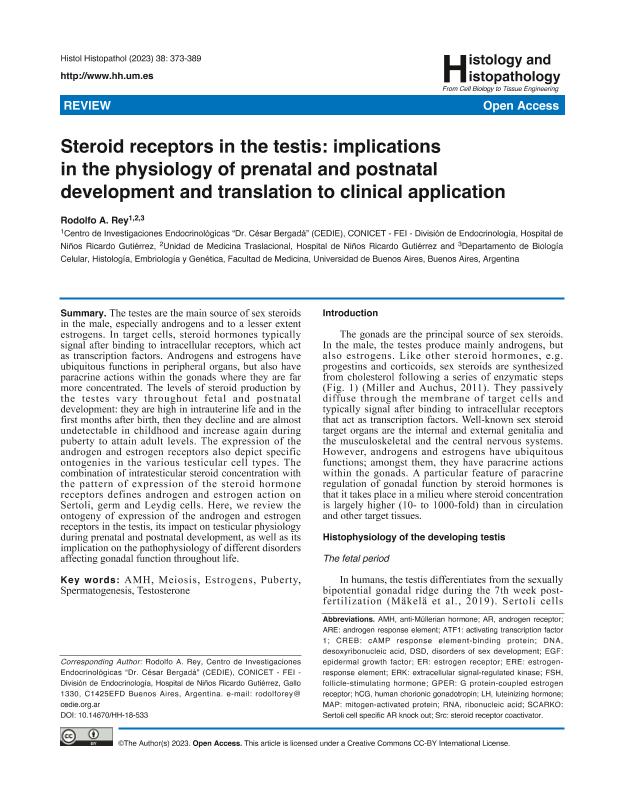Mostrar el registro sencillo del ítem
dc.contributor.author
Rey, Rodolfo Alberto

dc.date.available
2024-03-07T13:10:08Z
dc.date.issued
2023-03
dc.identifier.citation
Rey, Rodolfo Alberto; Steroid receptors in the testis: implications in the physiology of prenatal and postnatal development and translation to clinical application; Histology and Histopathology; Histology and Histopathology; 38; 4; 3-2023; 373-389
dc.identifier.issn
0213-3911
dc.identifier.uri
http://hdl.handle.net/11336/229704
dc.description.abstract
The testes are the main source of sex steroids in the male, especially androgens and to a lesser extent estrogens. In target cells, steroid hormones typically signal after binding to intracellular receptors, which act as transcription factors. Androgens and estrogens have ubiquitous functions in peripheral organs, but also have paracrine actions within the gonads where they are far more concentrated. The levels of steroid production by the testes vary throughout fetal and postnatal development: they are high in intrauterine life and in the first months after birth, then they decline and are almost undetectable in childhood and increase again during puberty to attain adult levels. The expression of the androgen and estrogen receptors also depict specific ontogenies in the various testicular cell types. The combination of intratesticular steroid concentration with the pattern of expression of the steroid hormone receptors defines androgen and estrogen action on Sertoli, germ and Leydig cells. Here, we review the ontogeny of expression of the androgen and estrogen receptors in the testis, its impact on testicular physiology during prenatal and postnatal development, as well as its implication on the pathophysiology of different disorders affecting gonadal function throughout life.
dc.format
application/pdf
dc.language.iso
eng
dc.publisher
Histology and Histopathology

dc.rights
info:eu-repo/semantics/openAccess
dc.rights.uri
https://creativecommons.org/licenses/by-nc-sa/2.5/ar/
dc.subject
STEROID
dc.subject
RECEPTOR
dc.subject
TESTIS
dc.subject
AMH
dc.subject.classification
Fisiología

dc.subject.classification
Medicina Básica

dc.subject.classification
CIENCIAS MÉDICAS Y DE LA SALUD

dc.title
Steroid receptors in the testis: implications in the physiology of prenatal and postnatal development and translation to clinical application
dc.type
info:eu-repo/semantics/article
dc.type
info:ar-repo/semantics/artículo
dc.type
info:eu-repo/semantics/publishedVersion
dc.date.updated
2024-02-28T10:36:54Z
dc.journal.volume
38
dc.journal.number
4
dc.journal.pagination
373-389
dc.journal.pais
España

dc.journal.ciudad
Madrid
dc.description.fil
Fil: Rey, Rodolfo Alberto. Consejo Nacional de Investigaciones Científicas y Técnicas. Oficina de Coordinación Administrativa Parque Centenario. Centro de Investigaciones Endocrinológicas "Dr. César Bergada". Gobierno de la Ciudad de Buenos Aires. Centro de Investigaciones Endocrinológicas "Dr. César Bergada". Fundación de Endocrinología Infantil. Centro de Investigaciones Endocrinológicas "Dr. César Bergada"; Argentina
dc.journal.title
Histology and Histopathology

dc.relation.alternativeid
info:eu-repo/semantics/altIdentifier/doi/http://dx.doi.org/10.14670/HH-18-533
dc.relation.alternativeid
info:eu-repo/semantics/altIdentifier/url/https://www.hh.um.es/Abstracts/Vol_38/38_4/38_4_373.htm
Archivos asociados
